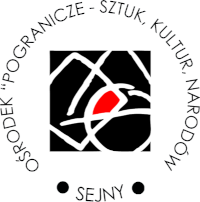Sejny Chronicles Workroom
I am standing in front of the synagogue. I can hear the Jewish songs, which once were sung here, I can see the Jewish market stalls and the Old Believers with their long beards. I hear a commotion -- shouts in Polish, Lithuanian, German, Russian, Yiddish… I can almost see menorah candles being lit in windows of Jewish homes on Friday night; I see beautiful Rachel on her shopping errands, I see the Roma men setting up camp by the river and the boy musician selling his accordion in front of the Round Shops. Many stories have been forgotten over time, so we want to memorialize those we have had the good fortune to hear and record.
Weronika Czyzewska, 14 years old
Borderland has been working with the children on discovering multicultural heritage of the Sejny region for years. The projects: Home, Nest, and Temple were fulfilled as parts of the cycle called Memory of Ancient Time. Sejny Chronicles, being created in children's theater workshop run by Bożena Szroeder, is a continuation of these projects. The program of Sejny Chronicles was carried on with the same group of children for 4 years in a series of meetings and artistic (theater, music, and plastic) workshops. After preparing a clay model of the town, the children arranged the performance Sejny Chronicles and a book under the same title which at the same time is a guide-book of Sejny and a documentation of the work with children. Last year a new group of children retook the task of studying the past of Sejny.
History of the Project
At first there was Our Old Good Sejny exhibition. The postcards and photographs from the years 1910 - 1960. When it was opened in 1998 there was only the collection being in possession of the Borderland Center. However, it developed rapidly: the children would bring their parents, grandparents, and they in turn would bring photographs, postcards, sometimes keepsakes which they had kept in their own home-archives. This is how the idea of the competition for children about Sejny history started. Approximately 100 various art and literary works were submitted and a dozen or so children were chosen to continue the project. They listened to the stories of their grandparents, created genealogical trees, note down life-histories of their parents. Then they started to match those stories with concrete places in Sejny. They drew half-true, half-mythical plan of the town on a large piece of cloth. They inserted there the legends (e.g. about Madonna from Sejny, about Rachel, Jewish tailor's daughter, or about the Gypsy woman that would sit on the tree), and the stories that they heard from their grandparents, as well as the names of Lithuanian, Polish, and Russian Old-believers families living in Sejny, and finally their own photographies.
The next stage was the building of the town. Clay tenant-houses, temples, and figures were made after the children learnt their stories, the stories of their past inhabitants and those who live there now. Children's imagination was stimulated by the legends and anecdotes that they noted down in small copy-books. This is how the unusual model of the town - with unique and poetic atmosphere - was created. It has become the icon of multicultural Sejny, and perfect scenography of the future theater performance.
The meetings with the older people who still remember old times and traditions were emotional. Thus generation gap and disregard for past (being the aim of socialist regime) were for the first time replaced by the contact between the young and the old, between the tradition and modernity, past and present.
Old people would often recollect the old music of the town. So the time to fill the town with songs and music, and mutual learinng of the songs has come. Lithuanian children would teach wedding and procession songs, the old-believers would teach spiritual "stichy", Polish children would teach folk songs. Also, Jewish "niguny" and Gypsy songs would be taught. The work was immersed in the fairy-tale poetics, therefore - and it was children's idea - the angels became the caretakers of the town. The angels were made of colorful pieces of cloth: the Angel of Love, the Angel of Peace, the Angel of Music, the Angel of Providence, the Angel of Household, the Angel of Life, the Angel of Bread and Water.
Clay town, stories, songs, and the Angels then played in the theater spectacle Sejny Chronicles. The material gathered by the children during their historical search was used in Sejny Chronicles book. The book is, one on hand, the guide through multicultural Sejny, and on the other - a documentation of the common work and method of work with the children.
Sejny Historic Cards were the next stage of work. They consisted the next element of Glass Beads Game project. The cards, with signs, symbols, and archetypes, attempt to create the universal language for communicating, derived from local traditions, myths, and wisdom. This language has been a base for intercultural game that would bring the broken-into-pieces world back together, like the pieces of the mosaic broken into many small fragments that remained separated for a long time.
Screeplay, directory, and workshop with children: Bożena Szroeder
Cooperation: Małgorzata Sporek-Czyżewska, Urszula Wasilewska, Jerzy Czyżyński, Wiesław Szumiński, Aneta Stabińska.






